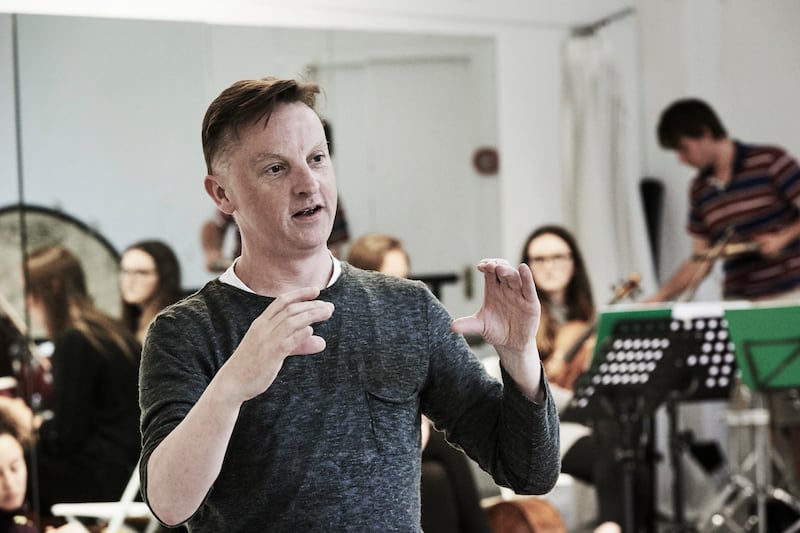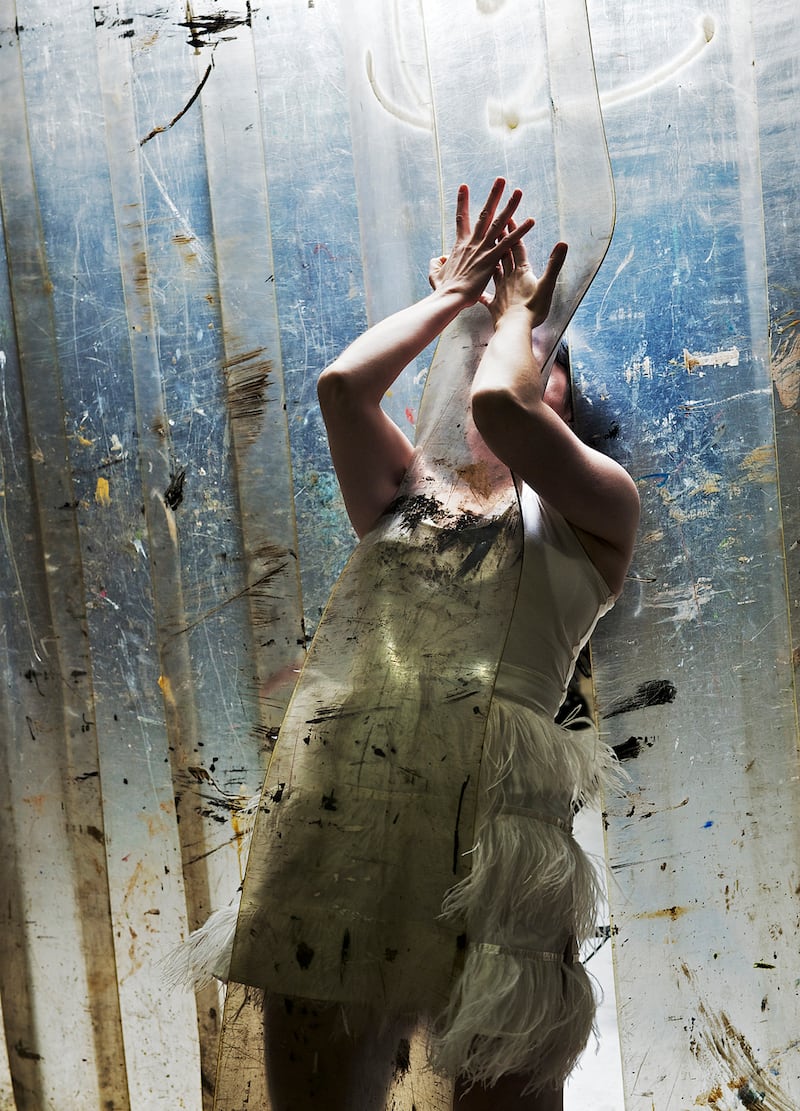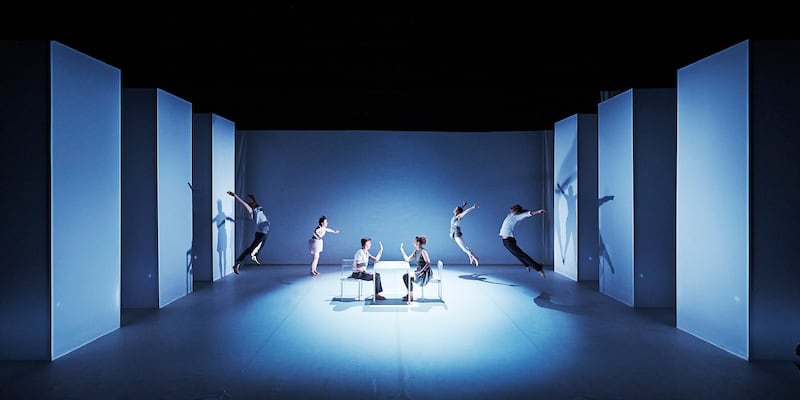Traditionally, a palimpsest is a scroll or work of art that is reused and written over. An animal-skin parchment is scrubbed almost clean and the scroll written upon again. Underneath the latest, most important words are hidden layers of other words in an evolving sedimentary process. Palimpsest is also the title of the most recent dance by CoisCéim Dance Theatre.
Premiering on March 15th as part of the St Patrick’s Festival, it will bring together dance, music and projections to look back at moments and people from local and national history. Conceptually the title is an apposite reflection of three decades of dances, movies and projects, as CoisCéim celebrates its 30th anniversary. Old works leave the repertoire and new ones take their place, building up layers of ideas, craft and inspiration.
On a quiet Saturday afternoon, the company’s artistic director, the choreographer David Bolger, is alone in the CoisCéim home in Fairview, in north Dublin. His pet lurcher, Alex, pads around the building as gentle piano music drifts from the studio. “I like to have quiet time to reflect like this,” says Bolger as he makes coffee. Thinking and reflecting are as much part of his creative process as studio time, particularly heading into a busy anniversary year.
As the company has produced almost 50 works, a natural conversation opener is identifying the highlights through those 30 years. Which dances or projects were milestones? Or springboards for further development? “It’s hard to know,” he says. “But I learned so many things from work that didn’t go as planned. From trying to discover why a particular piece didn’t turn out the way that I thought it would.”
READ MORE
These private artistic misgivings – the pieces that didn’t quite work, the idea never quite realised – are just as important to Bolger as the public successes. Hidden layers in the company’s make-up. The layers of the palimpsest that are written over.

After creating one-off works, Bolger established CoisCéim with Bridget Webster, a friend and fan who had offered help with input on productions. Webster was an engineer but had done some work with the visual-art collective Studio 16 and was looking for a possible change of career. “I’d always loved contemporary dance,” she says. Her teenage bedroom had a poster for London Contemporary Dance Theatre, and her father, a scientist, was also a classical pianist. “For me it was normal that a petroleum engineer would be interested in contemporary dance.”
With Webster as producer and Bolger as artistic director, they established CoisCéim as a young, vibrant dance company creating productions that were self-confident and funny. And they did so during a bleak time for contemporary dance in Dublin. After the Arts Council axed funding to Irish National Ballet and Dublin Contemporary Dance Theatre in 1988, concurrently eliminating more than 90 per cent of the total dance budget, smaller companies scrambled to mount works with small project grants. Studio space and venues were scarce throughout the 1990s, and those that existed were bleak. “Yes, there were obviously loads of challenges, but we didn’t really see them,” says Webster. “We only saw the opportunities.”
It might sound cliched, but the facts win out. Scarcely 12 months after the company was formed it was performing at Spring Loaded Season at the Place, home of London Contemporary Dance Theatre. It was a booking any Irish contemporary dance company would have killed for. “It was pre-Celtic Tiger, but you could feel there was this kind of confidence creeping into business and even in the arts,” says Bolger.
That confidence was evident in CoisCéim more than anywhere else. Several dances chart the company’s evolution, but two fast-tracked the company’s success and helped establish its identity. Hit and Run was a wild portrayal of the underworld that opened in January 1997 at Project @ the Mint, the temporary site for the theatre while its building on Essex Street in Temple Bar was being redeveloped. It had a bristling chutzpah in its scale, energy and concept.
It brought attention to the company outside of a typical dance audience. Writing in this paper in 1997, Fintan O’Toole marvelled at “how unusual a vibrant, self confident, joyous dance company still seems in contemporary Irish culture”. Although O’Toole didn’t refer to the wider dance community – an annoyance expressed on the letters page – his pinpointing of CoisCéim suppressing technical abstraction in favour of pure drama was exactly what was drawing audiences in increasing numbers.
Later that year the company premiered Ballads, a physical meditation on the Irish Famine. It was the first time Bolger engaged in deep research, a trait that has continued throughout his choreographic career. “Ballads was kind of a turning point for me,” he says. “I was really diving into research and looking at history and facts.” Lengthy research also gave rise to a shift in style. “I wanted to try and make a piece that was emotionally responsive to the Famine and not something that was going to lay blame. It was tricky. Up to that point I’d been funny, leaning more into the clown, which is fine. But I think the creation of Ballads began to enrich how I worked.”

By 2002 Hit and Run was turned into a dance film with the director John Comiskey and set in a ramshackle building near Poolbeg power station. It was broadcast on RTÉ and won jury prize at Dance on Camera, in New York, and the Paula Citron award at the Moving Pictures Festival, in Toronto. Ballads had already toured Tasmania and to the prestigious Jacob’s Pillow festival in the United States.
As repertoire grew, Bolger established his twin traits of visceral movement with conceptual ballast. Audiences were drawn to the dance’s immediacy but were challenged with conceptual depth and subtlety.
Webster’s role as producer seamlessly taken over by Jenny Traynor as success continued. In 2006 CoisCéim became the first Irish contemporary-dance company to be selected and perform at the Dance Biennale in Venice, in Italy. In 2007, Bolger and Cindy Cummings became the first choreographers to be elected to Aosdána.
Regular collaborators have sustained the growth. In the early days a group of artists formed around the company, including Muirne Bloomer, James Hosty, Liz Roche, Simone Litchfield and Jonathan Mitchell. Emma O’Kane was a frequent collaborator until her death, in 2021; the company has set up a bursary in her honour.
These dancers contributed to the research during the creative process, and Bolger still regards dancers as collaborators rather than passive instruments for his ideas. He recalls working with the director Trevor Nunn at the UK National Theatre, in London. “They were big shows with huge casts, but he knew how to get people to buy into his vision, even those that might have been pulling away. The psychology was fascinating, and I think that’s probably the job for the director or choreographer: try and read the room and keep everyone involved and engaged. It doesn’t always have to be happy – and in fact sometimes things come out of arguments. But I want people to be involved and to research. I don’t want to be doing it all.”

If Bolger doesn’t want to be prescriptive in making his own work, he also wants other artists working in CoisCéim’s Fairview premises to feel free from influence. He waves his hand towards the walls. “We deliberately don’t have posters of past shows,” he says; the aim is to create a neutral space free of even the most subliminal nudges. He would like the studio to provide a fulcrum in both the dance and the local communities.
“We had locals dropping in on our open house for Culture Night,” says Bolger, “and it was great to hear their memories of the building. In recent years it was a bridal shop, but it started life as a postal sorting office. I really like the idea that it was built to help communication and now it is still a centre of communication, this time through dance.”
This rootedness will serve the company as it looks towards the next 30 years. Bolger and Webster have begun exploring a succession plan – the artistic equivalent of making a will – to lead the company long into the future.
“It’s not an immediate conversation, but if something happened, what would we want?” says Bolger. “We want the company to go on and continue the opportunities that this building offers.”
“I would really hope that we could lay the foundations for somebody else to take on what the company stands for,” says Webster, “so that its vision and values go beyond the person.”
Long into the future, more layers will be added to the palimpsest.
Palimpsest, by CoisCéím Dance Theatre, opens at the Complex, Smithfield, Dublin 7, on Friday, March 15th, and runs until Sunday, March 17th, with previews from Wednesday, March 13th, as part of St Patrick’s Festival

















